Hiring skilled Keras developers is crucial for building robust machine learning models and deep learning applications. To ensure you're bringing the right talent on board, it's essential to ask targeted questions that assess candidates' proficiency in Keras during the interview process.
This blog post provides a comprehensive list of Keras interview questions, categorized to help you evaluate candidates at different experience levels. From basic concepts to advanced model training techniques and layer types, these questions will help you gauge a candidate's understanding of Keras and its practical applications.
By using these questions, you can effectively assess candidates' Keras knowledge and make informed hiring decisions. Consider using a pre-employment assessment to screen candidates before the interview stage, ensuring you focus your time on the most promising applicants.
Table of contents
10 Keras interview questions to initiate the interview
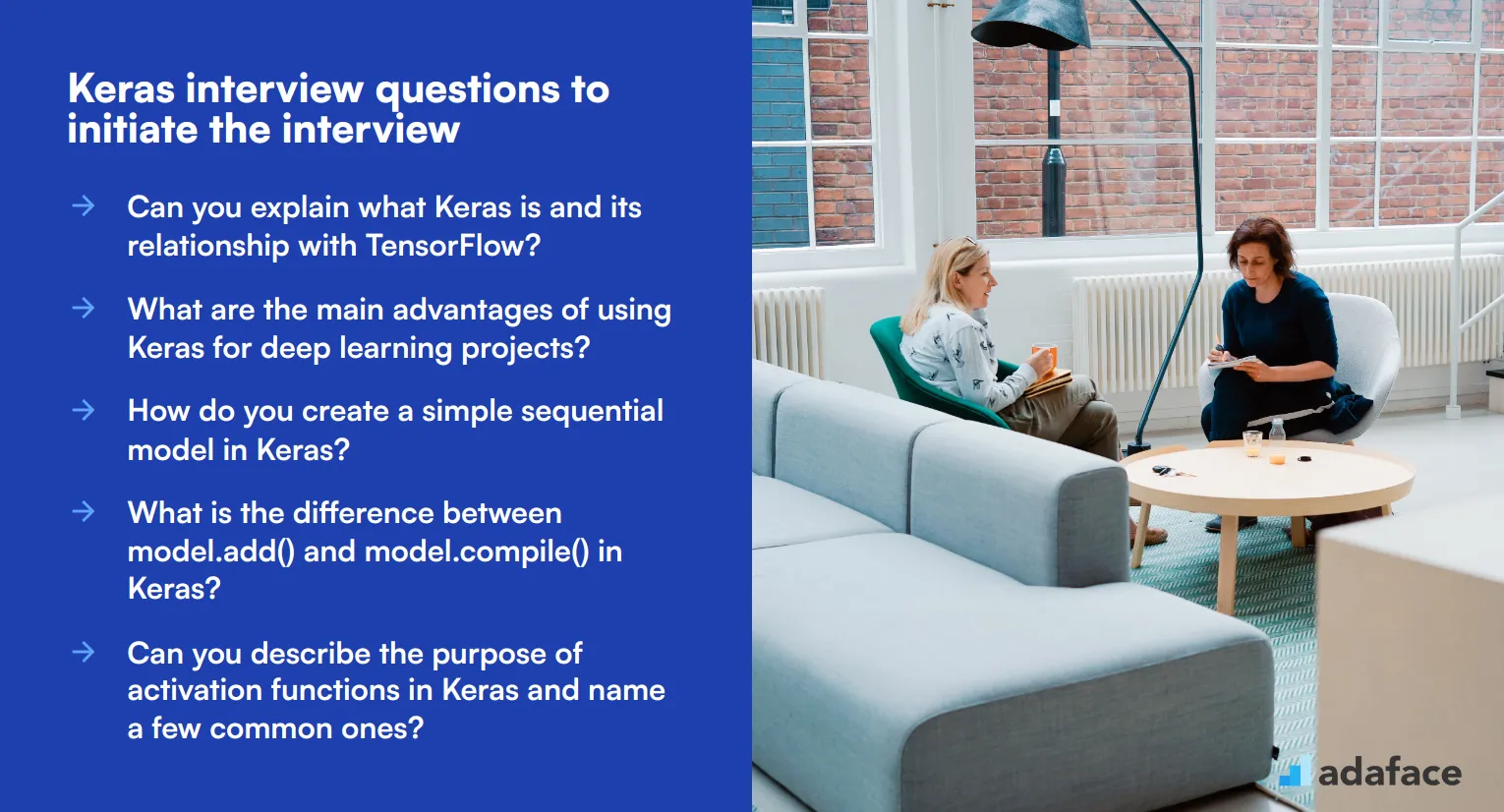
To kickstart your interview and gauge a candidate's foundational knowledge of Keras, consider using these 10 introductory questions. These queries are designed to help you assess the applicant's understanding of Keras basics and its application in machine learning projects.
- Can you explain what Keras is and its relationship with TensorFlow?
- What are the main advantages of using Keras for deep learning projects?
- How do you create a simple sequential model in Keras?
- What is the difference between model.add() and model.compile() in Keras?
- Can you describe the purpose of activation functions in Keras and name a few common ones?
- How do you handle overfitting in Keras models?
- What is the role of optimizers in Keras and can you name a few?
- Explain the concept of callbacks in Keras and provide an example of when you might use one.
- How do you save and load a Keras model?
- What is the difference between Keras functional API and sequential API?
8 Keras interview questions and answers to evaluate junior ML engineers
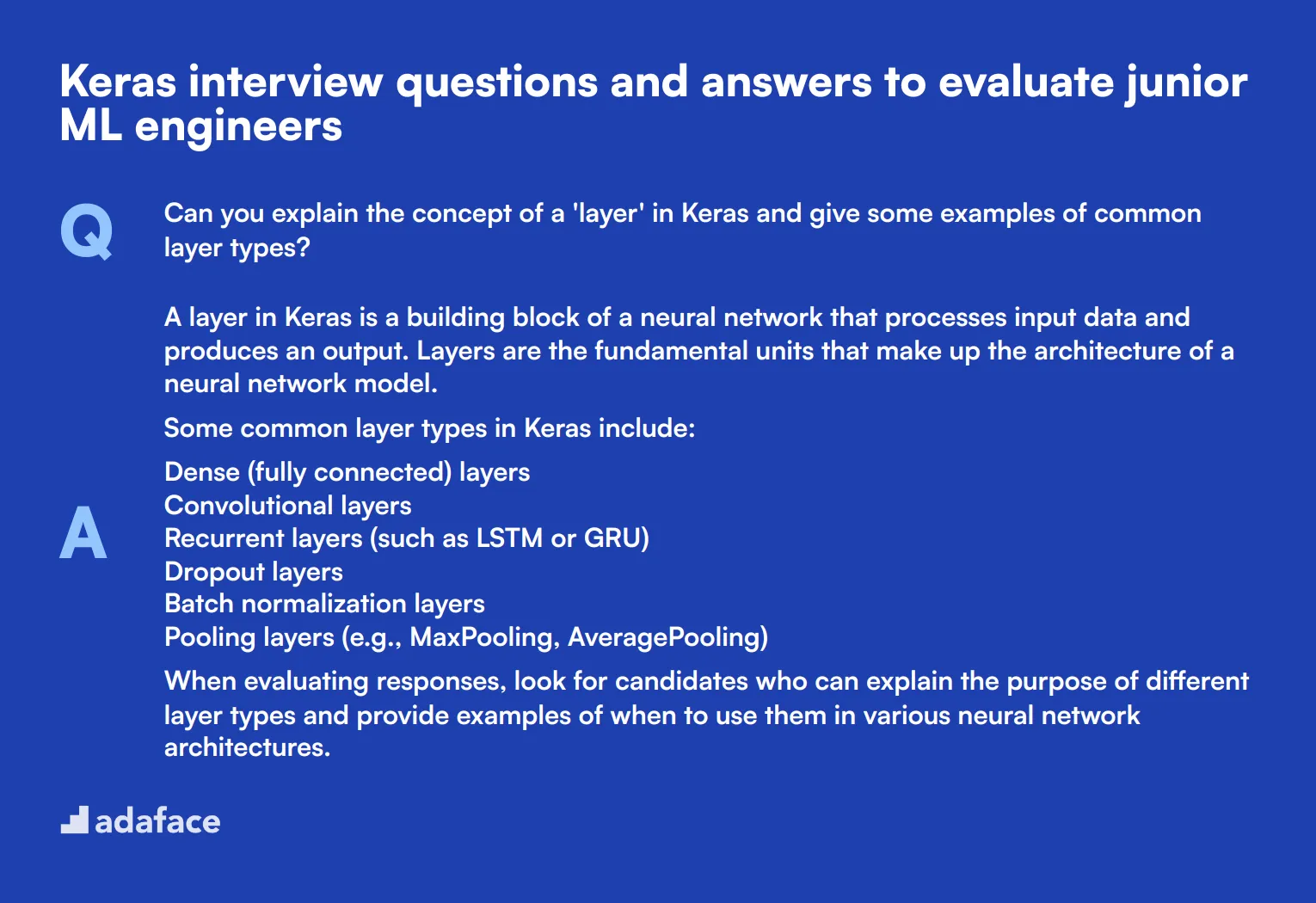
Ready to put your junior ML engineers to the test? These 8 Keras interview questions will help you evaluate their understanding of this popular deep learning framework. Use these questions to assess candidates' practical knowledge and problem-solving skills, ensuring you find the right fit for your machine learning team.
1. Can you explain the concept of a 'layer' in Keras and give some examples of common layer types?
A layer in Keras is a building block of a neural network that processes input data and produces an output. Layers are the fundamental units that make up the architecture of a neural network model.
Some common layer types in Keras include:
- Dense (fully connected) layers
- Convolutional layers
- Recurrent layers (such as LSTM or GRU)
- Dropout layers
- Batch normalization layers
- Pooling layers (e.g., MaxPooling, AveragePooling)
When evaluating responses, look for candidates who can explain the purpose of different layer types and provide examples of when to use them in various neural network architectures.
2. How would you handle imbalanced datasets in Keras?
Handling imbalanced datasets in Keras is crucial for developing effective machine learning models. Candidates should mention some of the following techniques:
- Class weighting: Assigning higher weights to underrepresented classes in the loss function.
- Oversampling: Increasing the number of samples in minority classes through techniques like SMOTE.
- Undersampling: Reducing the number of samples in majority classes.
- Data augmentation: Generating synthetic examples for minority classes.
- Using custom loss functions that are more sensitive to imbalanced data.
Look for candidates who can explain the pros and cons of different approaches and demonstrate an understanding of when to apply each technique based on the specific problem and dataset characteristics.
3. What is the purpose of the 'validation_split' parameter in Keras' fit() method?
The 'validation_split' parameter in Keras' fit() method is used to automatically set aside a portion of the training data for validation purposes. This helps in monitoring the model's performance on unseen data during training.
When a value between 0 and 1 is specified for validation_split, Keras will use that fraction of the training data as a validation set. For example, if validation_split=0.2, the last 20% of the training data will be used for validation.
Look for candidates who can explain the importance of validation in preventing overfitting and how it helps in tuning hyperparameters. They should also mention that using validation_split is a convenient alternative to manually splitting the data, but it may not be suitable for all scenarios, especially when data shuffling is important.
4. Explain the concept of early stopping in Keras and why it's useful.
Early stopping is a regularization technique used in Keras to prevent overfitting by monitoring the model's performance on a validation set during training. When the model's performance on the validation set stops improving or starts deteriorating, training is halted.
To implement early stopping in Keras, you use the EarlyStopping callback. This callback monitors a specified metric (e.g., validation loss) and stops training when the metric has stopped improving for a set number of epochs (patience).
Look for candidates who can explain the benefits of early stopping, such as reducing training time and preventing overfitting. They should also be able to discuss potential drawbacks, like the risk of stopping too early if the patience value is set too low. A strong candidate might also mention the 'restore_best_weights' option, which ensures the model retains the weights from its best performance.
5. How would you implement transfer learning using a pre-trained model in Keras?
Transfer learning in Keras involves using a pre-trained model as a starting point for a new task. The process typically includes the following steps:
- Load a pre-trained model (e.g., VGG16, ResNet) from Keras applications.
- Freeze the layers of the pre-trained model to prevent updating their weights.
- Add new layers on top of the pre-trained model to adapt it to the new task.
- Compile the new model with appropriate loss function and optimizer.
- Train the model, updating only the weights of the new layers.
Look for candidates who understand the concept of transfer learning and can explain its benefits, such as faster training and better performance on small datasets. They should also be able to discuss when to unfreeze some layers of the pre-trained model for fine-tuning and how to choose which layers to unfreeze based on the similarity between the original and new tasks.
6. What is the difference between model.fit() and model.fit_generator() in Keras?
model.fit() and model.fit_generator() are both methods used for training Keras models, but they serve different purposes:
- model.fit() is used when the entire dataset can fit into memory. It takes numpy arrays as input.
- model.fit_generator() is used for larger datasets that don't fit into memory. It takes a generator that yields batches of data.
Candidates should mention that in newer versions of Keras (TensorFlow 2.x), model.fit() can handle both in-memory data and generators, making model.fit_generator() deprecated. Look for understanding of when to use each method and awareness of the changes in recent Keras versions. Strong candidates might also discuss the benefits of using generators for data augmentation on-the-fly.
7. How would you implement a custom loss function in Keras?
Implementing a custom loss function in Keras involves defining a Python function that takes the true values and predicted values as arguments and returns the loss value. This function can then be passed to the model.compile() method.
Steps to implement a custom loss function:
- Define the loss function using TensorFlow operations.
- Ensure the function returns a scalar value.
- Use the @tf.function decorator for better performance (in TensorFlow 2.x).
- Pass the custom loss function to model.compile().
Look for candidates who can explain why custom loss functions might be necessary (e.g., for specific problem requirements or complex evaluation metrics) and demonstrate understanding of TensorFlow operations. Strong candidates might also discuss potential challenges in implementing custom losses, such as ensuring differentiability and numerical stability.
8. Explain the concept of a custom layer in Keras and when you might use one.
A custom layer in Keras is a user-defined layer that extends the base Layer class. It allows developers to create specialized layers that aren't available in the standard Keras library.
To create a custom layer, you need to implement at least three methods:
- init(): Initialize the layer and its parameters.
- build(): Create the layer's weights.
- call(): Define the layer's forward pass.
Custom layers are useful when you need to implement novel architectures, complex computations, or layers with learnable parameters that aren't available in standard Keras layers. Look for candidates who can provide examples of when custom layers might be necessary and demonstrate understanding of the Layer API. Strong candidates might also discuss the importance of making custom layers serializable for model saving and loading.
12 Keras interview questions about model training and evaluation
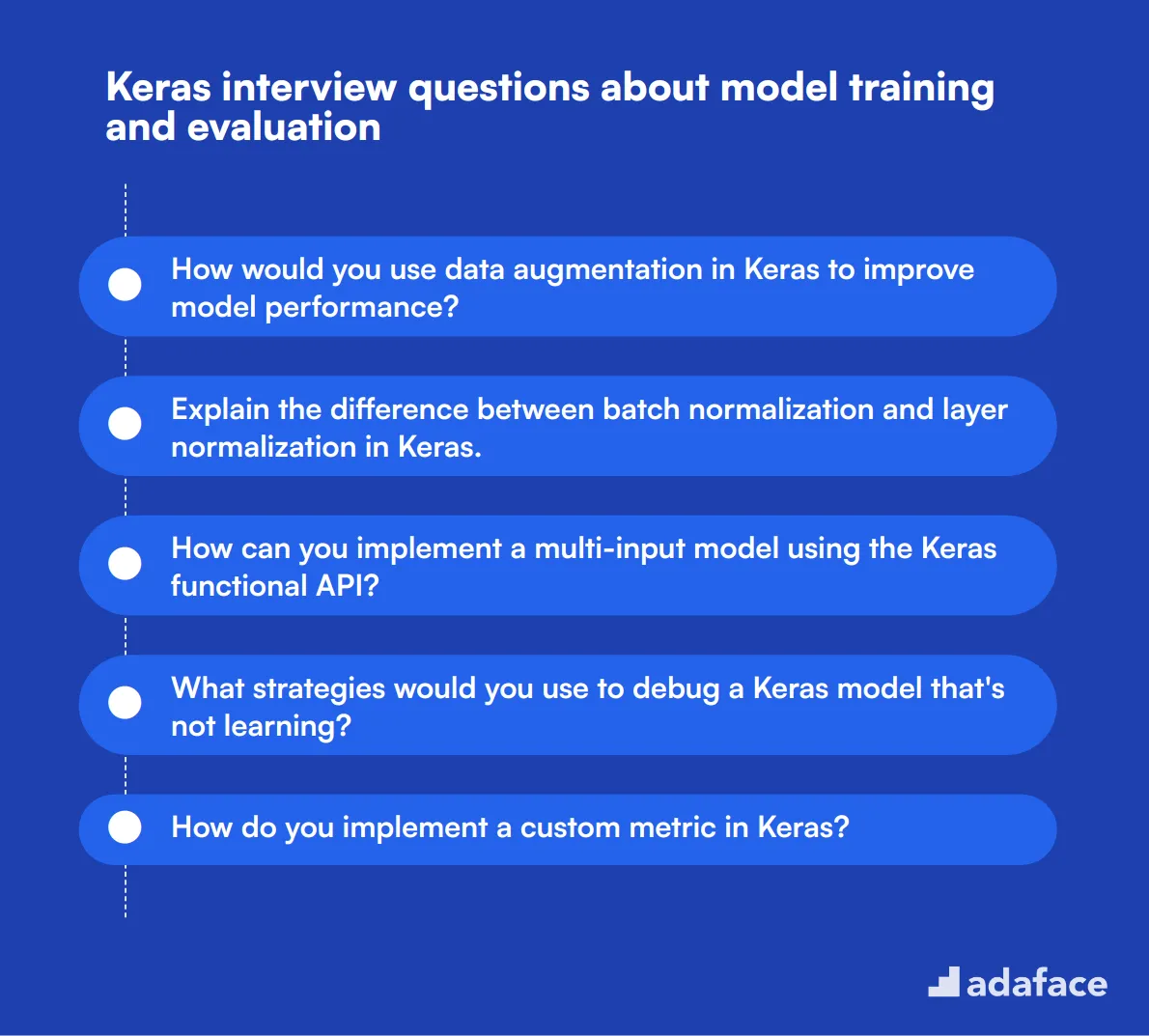
To assess a candidate's proficiency in model training and evaluation using Keras, consider asking some of these 12 interview questions. These questions will help you gauge the applicant's understanding of crucial concepts and practical skills essential for a machine learning engineer role.
- How would you use data augmentation in Keras to improve model performance?
- Explain the difference between batch normalization and layer normalization in Keras.
- How can you implement a multi-input model using the Keras functional API?
- What strategies would you use to debug a Keras model that's not learning?
- How do you implement a custom metric in Keras?
- Explain the concept of model checkpointing in Keras and how to implement it.
- How would you handle time series data preprocessing for a Keras LSTM model?
- What's the purpose of the 'class_weight' parameter in Keras' fit() method?
- How can you visualize the training process of a Keras model?
- Explain how to use Keras' ImageDataGenerator for real-time data augmentation.
- How would you implement a custom training loop in Keras?
- What's the difference between model.predict() and model.evaluate() in Keras?
8 Keras interview questions and answers related to layer types
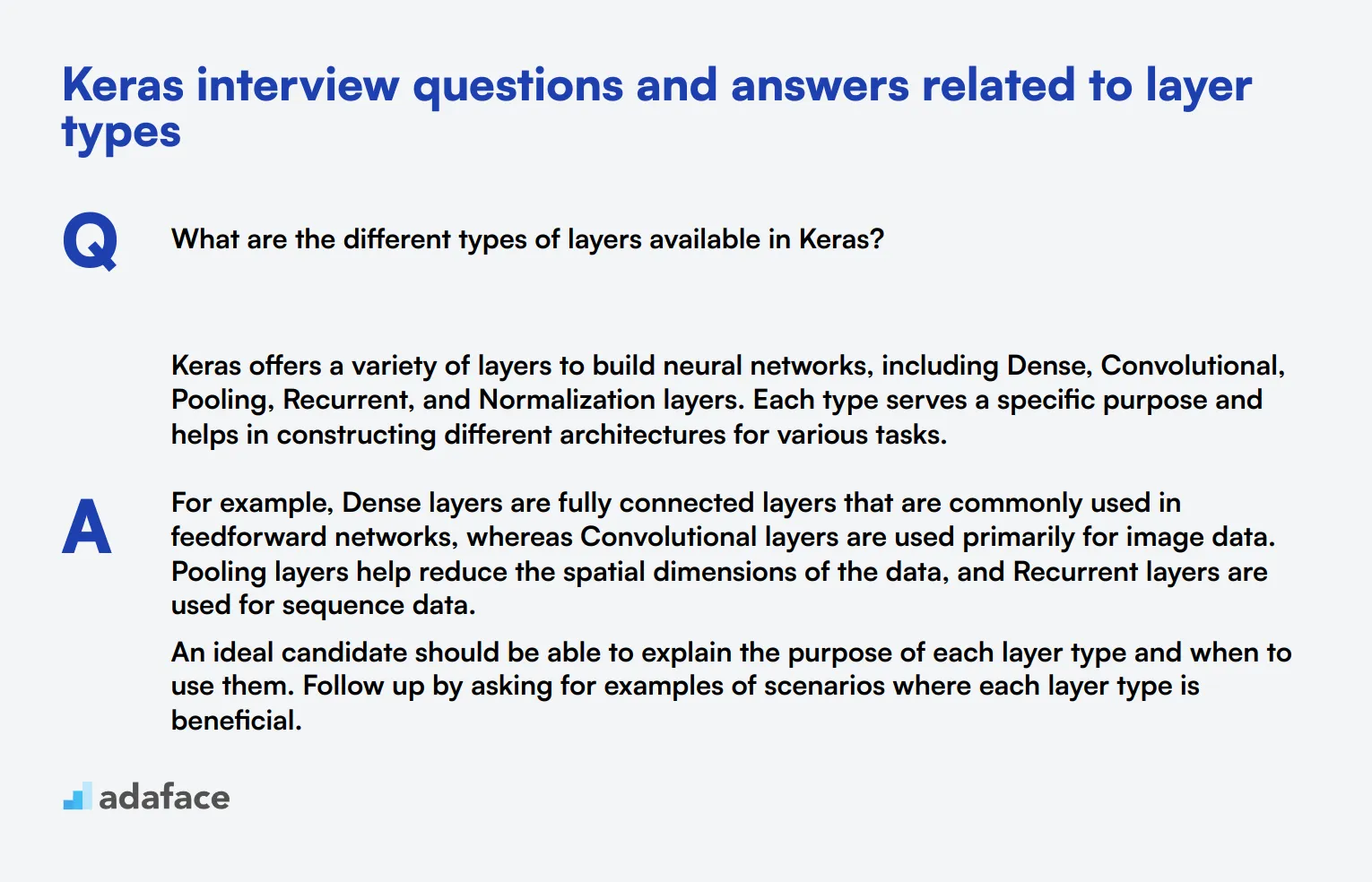
To ensure your candidates have a solid understanding of Keras' layer types, ask them these specific interview questions. These questions will help you evaluate their practical knowledge and ability to apply Keras concepts effectively.
1. What are the different types of layers available in Keras?
Keras offers a variety of layers to build neural networks, including Dense, Convolutional, Pooling, Recurrent, and Normalization layers. Each type serves a specific purpose and helps in constructing different architectures for various tasks.
For example, Dense layers are fully connected layers that are commonly used in feedforward networks, whereas Convolutional layers are used primarily for image data. Pooling layers help reduce the spatial dimensions of the data, and Recurrent layers are used for sequence data.
An ideal candidate should be able to explain the purpose of each layer type and when to use them. Follow up by asking for examples of scenarios where each layer type is beneficial.
2. How would you explain the use of the Dense layer in Keras?
The Dense layer in Keras is a fully connected layer where each input node is connected to each output node. It is frequently used in the final layers of a neural network to combine features and make predictions.
Dense layers are versatile and can be used in various types of neural networks, including feedforward and convolutional neural networks. They are particularly useful for tasks like classification and regression.
Look for candidates who can explain the importance of the Dense layer and provide examples of its application. Ideal responses will also mention how it can be combined with activation functions to introduce non-linearity.
3. Can you describe what a Convolutional layer does in a neural network?
A Convolutional layer in a neural network is designed to process grid-like data, such as images. It applies convolutional filters to the input data to detect various features like edges, textures, and patterns.
These layers are essential in tasks involving image recognition and computer vision. By using multiple Convolutional layers, a network can learn hierarchical feature representations, making it more effective at recognizing complex patterns.
Candidates should highlight their understanding of the role of Convolutional layers in feature extraction and their impact on model performance. They should also be able to provide examples of when to use these layers, such as in image classification tasks.
4. What is the purpose of Pooling layers in Keras?
Pooling layers are used to reduce the spatial dimensions of the data, thereby decreasing the computational load and helping to prevent overfitting. There are different types of pooling, such as Max Pooling and Average Pooling.
Max Pooling selects the maximum value from each patch of the feature map, while Average Pooling calculates the average. These layers help condense the information while retaining important features.
Interviewees should demonstrate an understanding of how Pooling layers contribute to dimensionality reduction and computational efficiency. Ask them to provide examples of scenarios where pooling is advantageous.
5. How do Recurrent layers differ from other layer types in Keras, and when would you use them?
Recurrent layers, such as LSTM and GRU, are designed to handle sequence data by retaining information from previous inputs. They are particularly useful for tasks like time series prediction and natural language processing.
Unlike other layers, recurrent layers have connections that loop back on themselves, allowing them to maintain a form of memory. This makes them ideal for tasks where the order of the data is important.
Candidates should be able to explain the unique characteristics of recurrent layers and provide examples of applications where they excel. Look for answers that mention specific tasks like language modeling or stock price prediction.
6. What is the role of Normalization layers in Keras?
Normalization layers, such as Batch Normalization, help stabilize and accelerate the training process by normalizing the input of each layer. They adjust and scale the activations, making the network less sensitive to the initial weights.
Batch Normalization, for instance, normalizes the output of a previous activation layer by subtracting the batch mean and dividing by the batch standard deviation. This helps in maintaining standardization of the inputs.
When discussing normalization layers, an ideal candidate should mention their benefits in improving training stability and speed. Follow up by asking how they would decide when to use normalization layers in a model.
7. Can you explain the concept of an Embedding layer in Keras and its applications?
An Embedding layer in Keras is used to convert categorical data, particularly text data, into dense vectors of fixed size. It is often used in natural language processing tasks to represent words or tokens in a continuous vector space.
This layer helps in capturing the semantic meaning of words by placing similar words closer to each other in the vector space. Embeddings are essential for tasks like sentiment analysis, machine translation, and more.
Look for candidates who can explain the purpose and benefits of using Embedding layers. Ideal answers will include examples of NLP tasks and mention the importance of embeddings in capturing semantic relationships.
8. What are Dropout layers and why are they used in Keras models?
Dropout layers are a regularization technique used to prevent overfitting in neural networks. During training, a Dropout layer randomly sets a fraction of input units to zero at each update, which helps the model generalize better.
By randomly dropping units, the network becomes less reliant on specific neurons, thus forcing it to learn more robust features. This technique is particularly useful in large networks where overfitting is a common issue.
Ideal candidates should be able to explain how Dropout layers contribute to regularization and provide examples of scenarios where they would use this technique. They should also mention the typical dropout rates and their impact on model performance.
Which Keras skills should you evaluate during the interview phase?
While it's impossible to fully gauge a candidate's capabilities in one interview, focusing on key Keras skills can greatly inform your decision. The following sections outline the essential skills to assess, why they are significant, and how you can effectively evaluate these during your interview process.
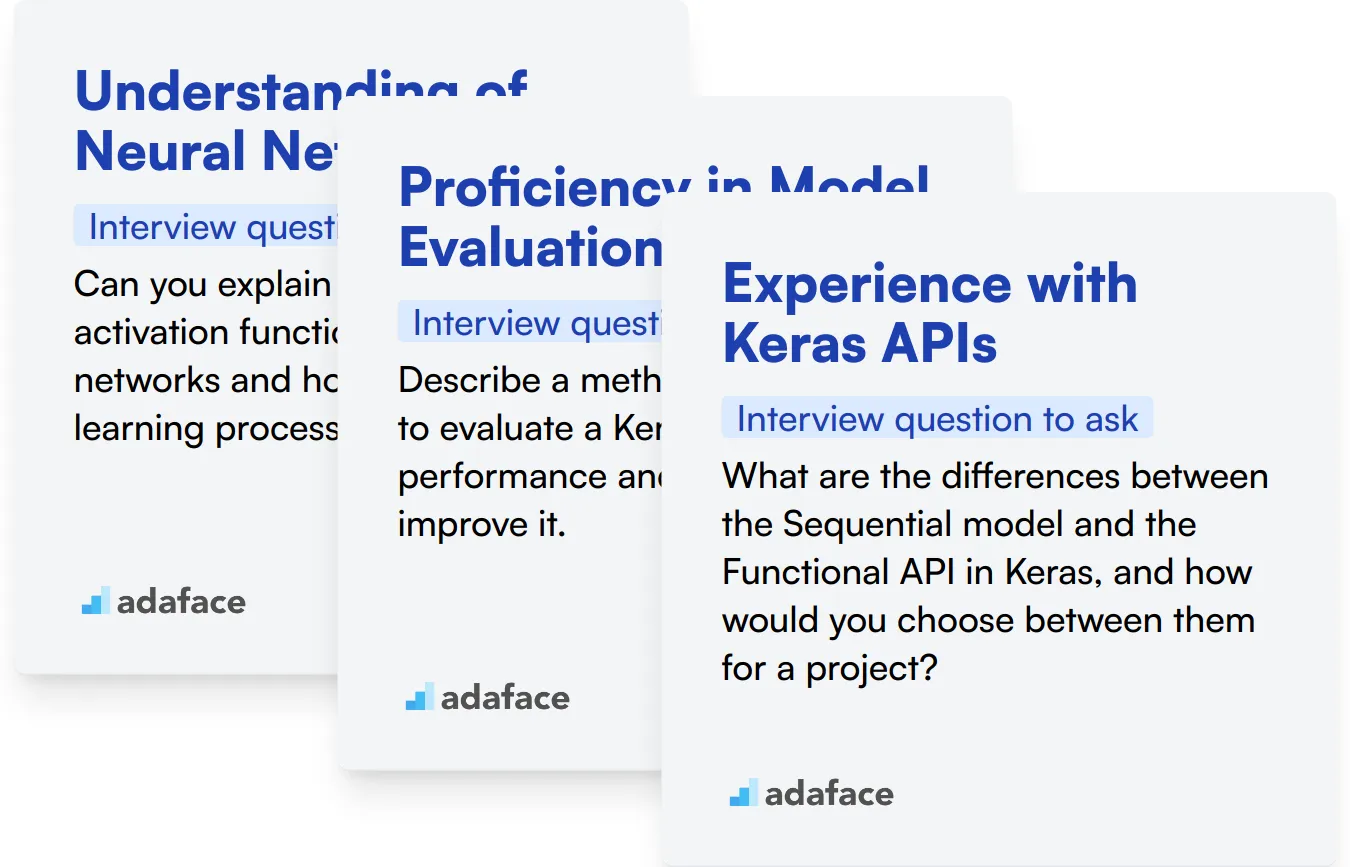
Understanding of Neural Networks
A fundamental understanding of neural networks is crucial for any machine learning engineer working with Keras, as it underpins the architecture they will work with. This includes comprehension of layers, activation functions, and how data is processed within a network.
To preliminarily assess this knowledge, consider using a tailored machine learning online test that includes multiple-choice questions (MCQs) specific to neural networks and their functionality in Keras.
For a deeper insight, introduce specific interview questions that focus on this area:
Can you explain the role of activation functions in neural networks and how they affect the learning process in Keras?
Look for answers that not only define activation functions but also demonstrate understanding of their impact on non-linear learning capabilities and network behavior during backpropagation.
Proficiency in Model Evaluation
Evaluating model performance accurately is key to deploying effective machine learning models. Candidates should be familiar with Keras tools and techniques for assessing model accuracy, overfitting, and underfitting.
An assessment test that includes questions on model evaluation metrics and techniques can help screen candidates on these crucial skills.
Additionally, pose real-world problem scenarios during interviews:
Describe a method you would use to evaluate a Keras model's performance and how you would improve it.
Candidates should demonstrate a methodical approach to model evaluation and the ability to apply techniques such as cross-validation, along with Keras-specific functions.
Experience with Keras APIs
Practical experience with Keras APIs is important for implementing various model architectures efficiently. This includes an understanding of the Sequential and Functional API capabilities and when to use them.
To gauge practical knowledge, it's effective to ask direct questions about Keras APIs:
What are the differences between the Sequential model and the Functional API in Keras, and how would you choose between them for a project?
The answer should reveal the candidate's ability to not only distinguish between these APIs but also to apply them appropriately based on the project requirements.
Effective Strategies for Utilizing Keras Interview Questions
Before you start implementing the insights from our discussion on Keras interview questions, here are a few strategic tips to enhance your interviewing process and make the most out of it.
1. Incorporate Pre-interview Skill Assessments
Using skill tests prior to interviews can streamline the candidate selection process by ensuring only the most suitable candidates reach the interview stage. This step is vital in verifying the practical abilities of candidates beyond their resumes.
For roles involving Keras, consider leveraging assessments such as the Deep Learning Online Test and the Machine Learning Online Test from Adaface. These tests evaluate essential skills that are directly relevant and provide a clear insight into the candidate’s capabilities.
Integrating these tests before the personal interview optimizes your time and helps in focusing on candidates who have proven their technical proficiency. With deeper insights from the test results, you can tailor your interview questions to probe areas where candidates may need further evaluation.
2. Curate Your Questions Wisely
Time is limited in interviews, so selecting the right amount and type of questions is key to evaluating candidates effectively. Focus on questions that cover critical Keras functionalities and model optimization techniques which are most relevant to your projects.
Relate your questions to broader machine learning and deep learning concepts. You might find it beneficial to include links to other technical areas; for instance, explore questions from our TensorFlow and Python OOPs interview question sets to gauge broader technical knowledge.
This strategy ensures that the discussion remains not only focused but also comprehensive, assessing both specific and related skills that are crucial for the role.
3. Emphasize Follow-Up Questions
Relying solely on preset interview questions may not always reveal a candidate's true competency. Follow-up questions are essential for digging deeper into their responses, helping to discern if they truly understand the concepts or have surface-level knowledge.
For example, if a candidate describes using a particular Keras optimizer, follow up by asking why they chose it over others for a specific type of project. This approach helps illuminate their decision-making process and practical understanding of the tool.
Using Keras Interview Questions and Skills Tests to Select Top Machine Learning Engineers
When hiring for roles requiring Keras expertise, confirming candidates' proficiency through direct questioning alone can be unreliable. A more accurate method is to implement specialized skills tests from the beginning of your recruitment process. This approach ensures only qualified candidates advance.
After candidates pass the skills tests, you can confidently shortlist the top performers for interviews. To streamline this process, consider signing up on our platform where you can manage assessments and review candidate scores all in one place.
Python Online Test
Download Keras interview questions template in multiple formats
Keras Interview Questions FAQs
Keras is a high-level neural networks API, written in Python and capable of running on top of TensorFlow, CNTK, or Theano.
Look for strong understanding of neural networks, experience with model training and evaluation, and familiarity with different layer types.
Ask about past projects, specific challenges they faced, and the solutions they implemented using Keras.
Yes, practical experience with building, training, and deploying models in Keras can significantly demonstrate a candidate's proficiency.
Common challenges include handling overfitting, optimizing model performance, and managing large datasets.
Use specific questions about model creation, training, and evaluation, and assess their understanding of fundamental concepts and layer types.

40 min skill tests.
No trick questions.
Accurate shortlisting.
We make it easy for you to find the best candidates in your pipeline with a 40 min skills test.
Try for freeRelated posts
Free resources




